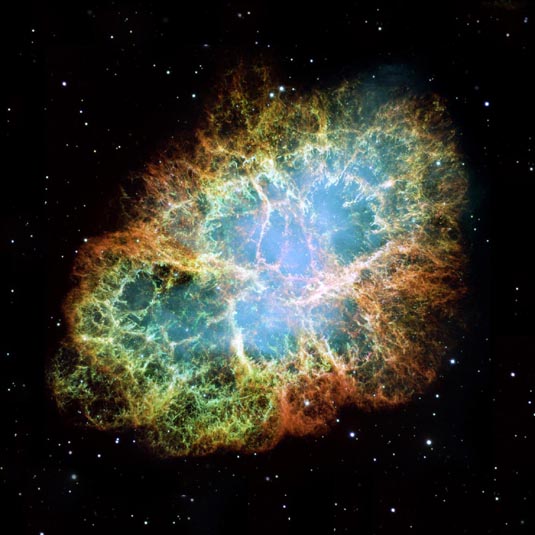
Description: Supernova Remnant
Position (J2000): R.A. 05h 34m 32s Dec. 22° 00' 52"
Constellation: Taurus
Distance: 6500 light-years (2.0 kpc).
Dimensions: The image is 6 arcminutes along the bottom
(12 light-years or 3.7 pc).
Instrument: WFPC2
Exposure Date(s): October 1999, January 2000, and December 2000
Filters: F502N ([O III]), F631N ([O I]), F673N ([S II])
Image Credit: NASA, ESA and J. Hester (Arizona State University)
Release Date: December 1, 2005
Other images: S9948eo S0504sp S0537a S0537b S0909sp
ABOUT THIS IMAGE:
This is a mosaic image,
one of the largest ever taken by NASA's Hubble Space Telescope of the
Crab Nebula, a
six-light-year-wide expanding remnant of a star's supernova explosion.
Japanese and Chinese astronomers recorded
this violent event nearly 1,000 years ago in 1054, as did, almost certainly,
Native Americans.
The orange filaments
are the tattered remains of the star and consist mostly of hydrogen. The
rapidly spinning neutron
star embedded in the center of the nebula is the dynamo powering the nebula's
eerie interior bluish glow. The blue light
comes from electrons whirling at nearly the speed of light around magnetic
field lines from the neutron star. The neutron
star, like a lighthouse, ejects twin beams of radiation that appear to
pulse 30 times a second due to the neutron star's
rotation. A neutron star is the crushed ultra-dense core of the exploded
star.
The Crab Nebula derived
its name from its appearance in a drawing made by Irish astronomer Lord
Rosse in 1844,
using a 36-inch telescope. When viewed by Hubble, as well as by large
ground-based telescopes such as the
European Southern Observatory's Very Large Telescope, the Crab Nebula
takes on a more detailed appearance that
yields clues into the spectacular demise of a star, 6,500 light-years
away.
The newly composed
image was assembled from 24 individual Wide Field and Planetary Camera
2 exposures taken in
October 1999, January 2000, and December 2000. The colors in the image
indicate the different elements that were
expelled during the explosion. Blue in the filaments in the outer part
of the nebula represents neutral oxygen, green is
singly-ionized sulfur, and red indicates doubly-ionized oxygen.